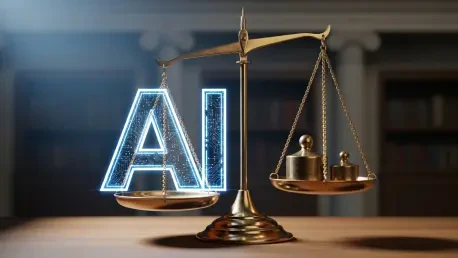In an era where legal professionals grapple with mounting caseloads and shrinking timelines, a staggering statistic emerges: over 60% of lawyers report spending more than half their time on repetitive administrative tasks like drafting documents and reviewing contracts, which hampers productivity. This burden not only limits access to justice for those who cannot afford prolonged legal processes but also highlights the need for innovative solutions. Enter generative AI, a transformative technology promising to revolutionize the legal field by automating routine work and enhancing efficiency. This review dives deep into the capabilities, real-world applications, and challenges of generative AI in law, assessing its potential to reshape an industry steeped in tradition while navigating the ethical and technical hurdles that accompany such innovation.
Core Features and Technical Capabilities
Document Drafting and Review Efficiency
Generative AI stands out for its remarkable ability to draft legal documents and review contracts with unprecedented speed. Leveraging advanced natural language processing and machine learning algorithms, these tools can produce initial drafts of agreements, pleadings, and memos in a fraction of the time it takes a human lawyer. Performance metrics often highlight a reduction in drafting time by up to 70%, allowing legal teams to focus on strategic analysis rather than mundane formatting or clause insertion.
Beyond speed, the accuracy of these systems is a critical factor. While many platforms boast high precision in identifying standard clauses and flagging inconsistencies, they occasionally falter with nuanced or context-specific language, requiring human intervention. This balance of automation and oversight underscores the technology’s role as a supportive tool rather than a standalone solution, significantly lightening the workload for attorneys burdened by repetitive tasks.
Legal Research and Case Summarization Prowess
Another cornerstone of generative AI in the legal sphere is its capacity to streamline research and summarize complex case law. By processing vast databases of legal texts, statutes, and precedents, these tools can generate concise summaries that distill essential points, saving hours of manual reading. Law firms report that such capabilities enhance their ability to prepare for cases swiftly, especially when tight deadlines loom.
However, the technology is not without limitations. While it excels at identifying relevant cases and extracting key arguments, it sometimes produces incomplete or overly generalized summaries that miss critical nuances. Educational settings, where students rely on these summaries for learning, have noted the importance of cross-verifying outputs to ensure depth and accuracy, highlighting the need for a hybrid approach in analytical tasks.
Real-World Performance and Adoption Trends
Deployment Across Legal Environments
In practice, generative AI has found a foothold in diverse legal settings, from sprawling law firms to compact in-house departments. Large firms utilize the technology to automate routine document preparation, enabling attorneys to handle higher volumes of cases without sacrificing quality. In-house teams, often constrained by limited resources, leverage AI to boost productivity, ensuring compliance and contract management are handled efficiently.
A particularly inspiring application lies in pro bono initiatives, where generative AI aids under-resourced legal aid organizations. By automating initial client intake forms and basic legal advice drafts, the technology helps bridge the justice gap for underserved communities. Such deployments demonstrate not just operational benefits but also a broader societal impact, aligning with the legal profession’s commitment to equity.
Emerging Trends in Usage and Acceptance
Adoption trends reveal a growing acceptance of generative AI, particularly among younger attorneys and law students who view it as an integral part of modern practice. Surveys indicate that over 60% of legal professionals now use these tools occasionally, with a significant portion integrating them into daily workflows under regulated conditions. This shift reflects a cultural evolution within the industry, moving toward tech-savvy approaches.
Moreover, recent developments show a focus on secure platforms tailored for legal use. Many firms now prioritize tools with built-in data protection measures to safeguard client confidentiality, addressing one of the primary concerns around AI adoption. The push for standardized ethical guidelines also gains traction, as stakeholders aim to balance innovation with accountability in an increasingly digital landscape.
Challenges and Performance Drawbacks
Technical and Accuracy Issues
Despite its promise, generative AI in law faces notable technical challenges that temper its effectiveness. One prominent issue is the occurrence of “hallucinations,” where the AI generates inaccurate or fabricated information, such as nonexistent case citations or incorrect legal interpretations. High-profile incidents have exposed these flaws, emphasizing the necessity of rigorous verification by trained professionals.
Additionally, the technology struggles with highly specialized or jurisdiction-specific legal contexts, where its outputs may lack the precision required for actionable advice. This limitation poses a risk in high-stakes scenarios, where errors can lead to costly mistakes. Continuous improvements in training datasets and algorithms are essential to mitigate these shortcomings and enhance reliability.
Ethical and Security Concerns
Ethical dilemmas and data security remain at the forefront of challenges for generative AI in legal applications. With sensitive client information at stake, breaches or misuse of data could undermine trust in the profession. A significant majority of legal professionals express concern over confidentiality, pushing for stricter internal policies and approved tools to ensure safe usage.
Regulatory hurdles further complicate adoption, as varying standards across regions create uncertainty about compliance. Disparities in access to reliable AI platforms also hinder equitable integration, with smaller firms often lacking the resources to implement secure systems. Addressing these issues requires collaborative efforts between legal institutions, tech providers, and policymakers to establish robust frameworks.
Verdict and Path Forward
Reflecting on this comprehensive evaluation, generative AI proves to be a powerful ally in the legal profession, offering substantial gains in efficiency and accessibility through its automation of routine tasks and research support. Its performance in drafting and summarization impresses, though it stumbles on accuracy in complex scenarios and raises valid concerns about data security and ethics. The technology demonstrates immense potential to transform legal workflows when paired with human oversight.
Looking ahead, the next steps for stakeholders involve prioritizing the development of secure, specialized platforms that address the unique needs of the legal field. Investment in training programs for attorneys to understand AI limitations and best practices emerges as crucial. Collaborative policy-making to standardize ethical guidelines stands out as a vital action to ensure responsible adoption. By focusing on these initiatives, the legal industry can harness generative AI’s strengths, paving the way for a more innovative, equitable, and effective practice landscape.









